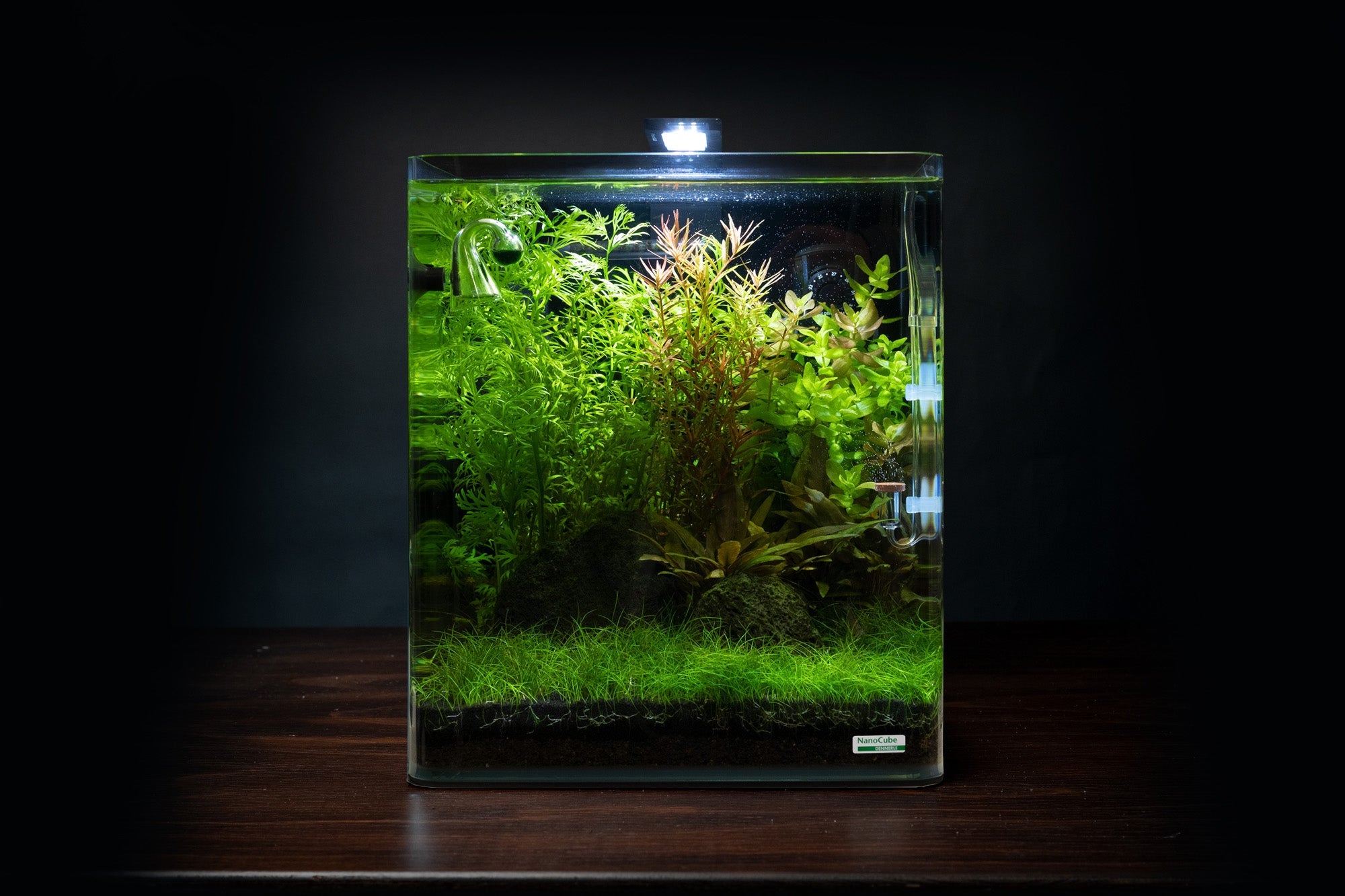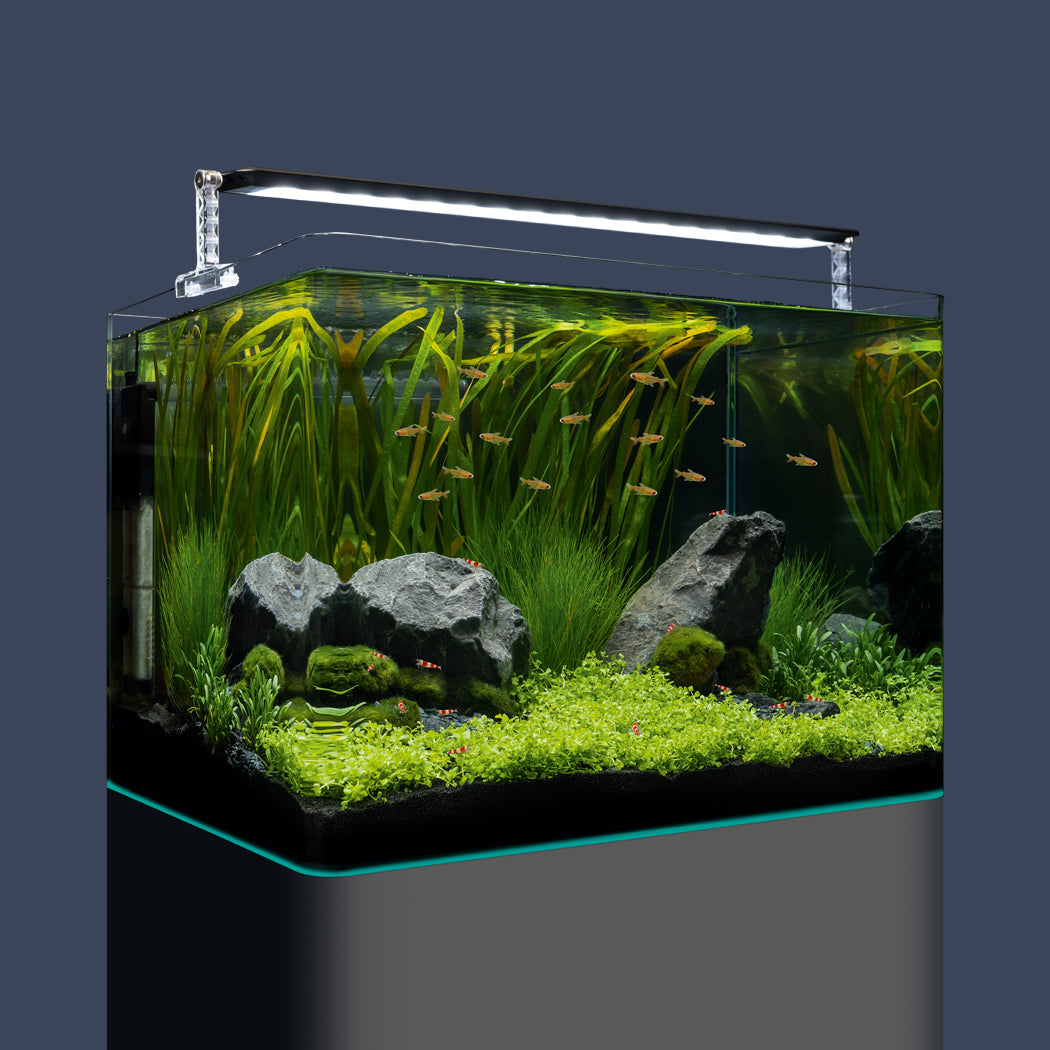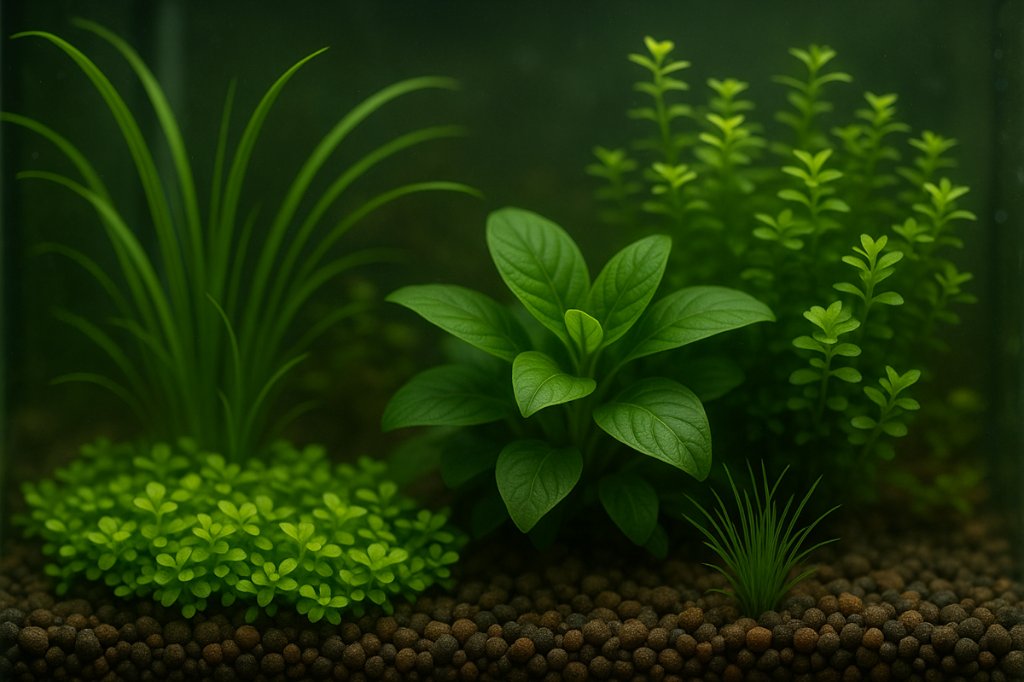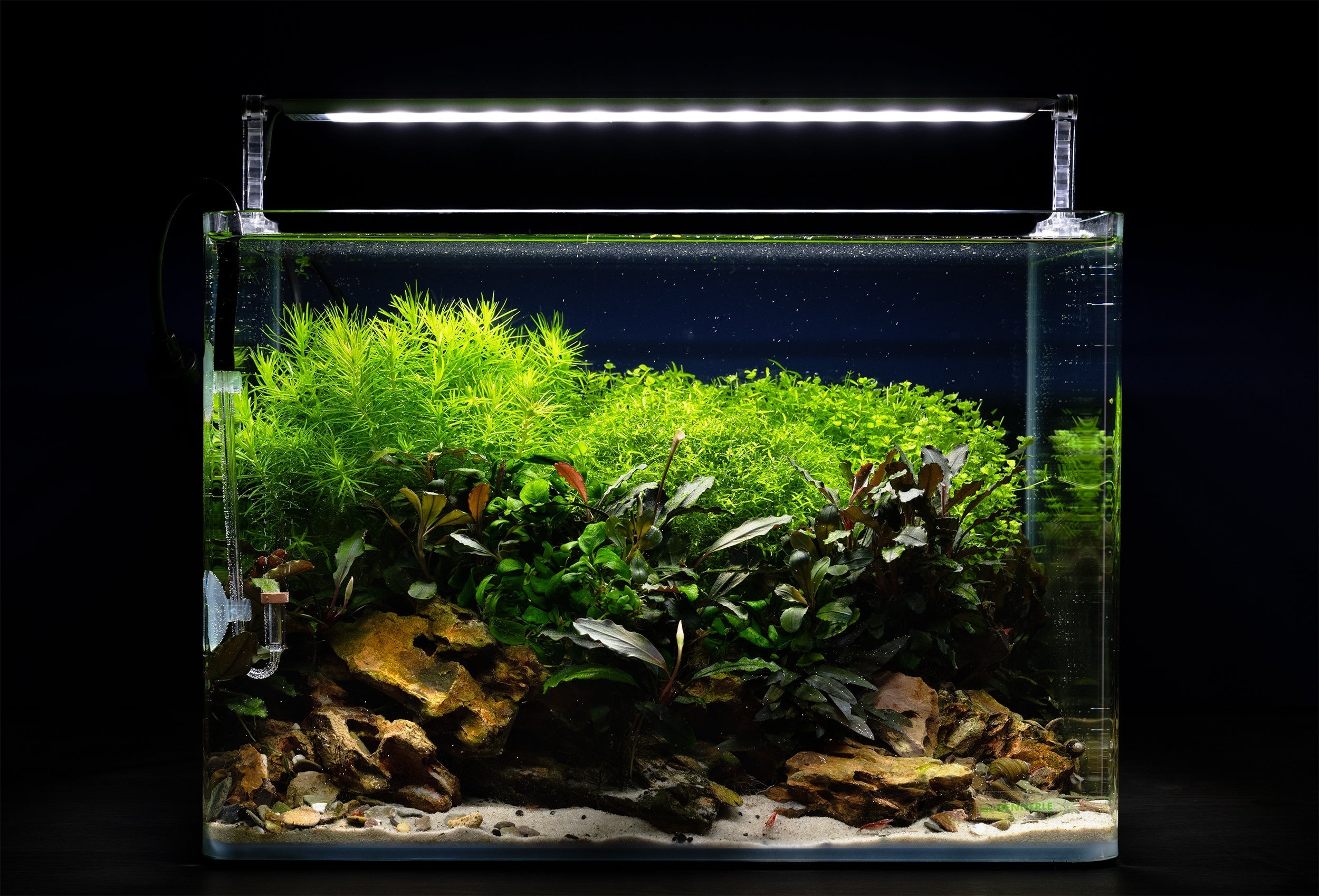The start-up phase
Once the aquarium is set up, it gets exciting – now the start-up phase begins. The plants grow and sprout new leaves. To do this, they use nutrient reserves that they bring with them from growing up, which is why you only start fertilizing in the second week with half the recommended dose. Then in the third week you go to the full amount.
The pollutant-degrading bacteria, which colonize all surfaces in the aquarium and especially in the filter, now begin to multiply. Biofilms are formed, which you can feel after a few days as a slippery surface on the inside of the aquarium glass.
Only when the biological decomposition of pollutants by the purification bacteria is underway can you introduce animals. You can recognize this by the fact that the nitrite value in the aquarium water initially rises (the so-called nitrite peak) and then falls to zero. This should be the case after about three weeks.
It is best not to introduce all animals at once, but gradually at intervals of 1 – 2 weeks, so that the filter bacteria can adapt to the increasing load.
You can accelerate the start-up phase with the aid of cleaning bacteria contained in Dennerle Aquarium Starter Rapid. The first insensitive animals such as aquarium snails, shrimps and catfish can be introduced after just 24 hours. After three weeks, the rest of the fish can be added step by step.
The start-up plan
Week 1
- Water change = 50 %
- Fertilization = not yet
- Lighting time = 4 hrs. light, 2 hrs. break, 4 hrs. light
Week 2
- Water change = 50 %
- Fertilization = 50 % of the recommended normal dosage
- Lighting time = 4.25 hrs. light, 2 hrs. break, 4.25 hrs. light
Week 3
- Water change = 50 %
- Fertilization = normal dosage
- Lighting time = 4.5 hrs. light, 2 hrs. break, 4.5 hrs. light
Week 4
- Water change = 25 %
- Fertilization = normal dosage
- Lighting time = 4.75 hrs. light, 2 hrs. break, 4.75 hrs. light
Week 5
- Water change = 25 %
- Fertilization = normal dosage
- Lighting time = 5 hrs. light, 2 hrs. break, 5 hrs. light
Lighting time
Most aquarium plants originate from the tropics – we should orientate our aquarium lighting on this. It often rains over midday in these regions, so the sun does not shine for 1 – 2 hours. In the morning and evening, the angle of incidence of the sun's rays is flatter, so that less light falls into the aquatic environment.
Experience shows that a daily lighting time of 10 hours is good for the aquarium. We mimic the cloudy period with a midday break, during which you turn off the aquarium lighting for 2 hours so that the plants can recover from their photosynthetic activity and break down harmful metabolic products. Plants love this midday break, but algae do not like it very much.
For a running aquarium we recommend 5 hours light – 2 hours break – 5 hours light.
During the start-up phase, gradually increase the lighting time from 8 to 10 hours per day. This will give the plants time to adjust and prevent algae growth.
Select the light rhythm in the aquarium so that the light is still on when you want to observe your animals in the evening. To avoid disturbing the biorhythms of your aquarium inhabitants, the lighting time should be the same every day – with a timer, everything runs automatically. A possible schedule would be:
10:00 – 15:00 light ON
15:00 – 17:00 light OFF (lunch break)
17:00 – 22:00 light ON
Water values
Having an aquarium does not mean that you have to become an expert in water chemistry, but you should know the most important water values. You can find out the values of your tap water from your water company.
The common fish and invertebrates found in pet stores do well with tap water. Species with special requirements need appropriately treated water. With the Dennerle reverse osmosis system you can produce very soft water, which you can easily and specifically bring to the right values with our hardening salts.
You can measure the most important water values with the Dennerle WaterTest 6in1 with sufficient accuracy for aquaristic purposes. Drop tests from the specialist trade are even more accurate.
If the aquarium is biologically stable, the animals are healthy and active, the plants grow well and there are no algae problems, you theoretically do not need to measure – although the water chemistry can be quite interesting!
The most important values briefly explained:
Total hardness (GH)
Hard water has a GH of more than 14 °dH, medium hard water of 7.3 – 14 °dH and soft water of less than 7.3 °dH.
Carbonate hardness (KH)
Carbonate hardness binds acids and buffers the pH at approximately 7 – 7.5.
pH value
Acidic water has a pH below 7, alkaline above 7. If the pH is exactly 7, it is neutral.
Ammonium/ammonia (NH4 / NH3)
The non-toxic plant nutrient ammonium (NH4) is formed during the decomposition of organic pollutants. It increasingly converts to toxic ammonia at alkaline pH values. In a stable running aquarium NH4 is not detectable.
Nitrite (NO2)
Nitrite, which is toxic to fish, is formed during ammonium decomposition by filter bacteria. Nitrite should not be detectable in the aquarium water.
Nitrate (NO3)
The filter bacteria turn nitrite into the relatively harmless nitrate, an important plant nutrient.
Phosphate (PO4)
An important plant nutrient that is non-toxic in aquarium concentrations.
Correctly introduce fish and shrimp
To avoid stress, turn off the light before introducing the animals and let the unopened bag float on the water surface for about 15 minutes to adjust to the temperature. Then open the bag and add a sip of aquarium water every 5 minutes so that the animals can slowly get used to the new water values.
When after 30 – 45 minutes the ratio of aquarium water to transport water is about 3:1, carefully catch the animals with a landing net and put them into the aquarium. The water from the bag should not get into the tank because of possible pathogens. Turn on the light after 1 – 2 hours. Feed the animals only the next day to facilitate their acclimation.
Algae
During the start-up phase of your aquarium, algae may appear more frequently because the plants, as their counterparts, first have to get used to the new environmental conditions and take root. During the changeover phase, they do not yet absorb as many nutrients from the water, which are thus available to the algae.
Different types of algae and their causes
Diatoms usually appear first. They consume silicate from the tap water and form brown coatings. Normally they disappear by themselves if the aquarium filter works properly.
The diatoms are followed by green algae – green coatings and very short to long filaments. They like to take advantage of nutrient imbalances and often indicate that there is too much or too little nitrate in the aquarium.
Red algae usually grow in clumps or brushes. They often appear when there is an excess of iron.
Once the plants are growing well and the aquarium has biologically stabilized, the algae will be pushed back. Algae-eating animals will help you stop emerging algae growth.
Proven algae eaters
Amano shrimp (Caridina multidentata)
- Recommended stocking: group of 5 or more, 54 liters or larger.
- Eaten algae: Diatoms, green algae cover, filamentous algae.
Eared lattice catfish (Otocinclus sp.)
- Recommended stocking: group of 6 or more, 54 liters or more
- Eaten algae: Diatoms, green algae coverings, young filamentous algae.
Zebra racing snail (Vittina sp.) / staghorn snail (Clithon sp.)
- Stocking recommendation: 1 snail per 10 liters, Clithon from 20 liters, Vittina from 54 liters.
- Eaten algae: Diatoms, green algae coverings
Dwarf shrimps (Neocaridina sp.)
- Stocking recommendation: group from 10, from 20 liters.
- Eaten algae: Diatoms, green algae coverings
Care
Daily control
Every day you should briefly check whether the filter, light and CO2 addition are working, whether the water temperature is suitable and whether the water is clear. The behavior of the fish is also important: Are they breathing calmly and relaxed? Do they appear healthy? Do you see signs of disease such as white spots, "wadded up" coatings on their mucous membranes, or fin damage?
How are your shrimp behaving? Are they actively grazing the substrate? If so – congratulations, your aquarium is doing well!
Water care
It is best to choose a fixed day of the week for aquarium maintenance.
Particularly important is the weekly partial water change of at least 25 %. You will remove waste, pollutants and inhibitors and refill with fresh, clean water. The fresh water should have approx. 18 – 25 °C. This regular water change can ensure long-term healthy aquarium inhabitants and magnificent plants and prevent algae problems.
However, tap water is treated for us humans. It may contain substances that are toxic to fish, such as chlorine, and lack other substances, such as colloids and humic substances, that protect fish and that they are used to from their home waters. You should therefore treat tap water with Dennerle Aqua Elixier before filling it into the aquarium to make it safe for fish, shrimps & co, to bind dangerous chlorine and heavy metals and to add substances that protect the mucous membranes.
During the partial water change, it is best to also clean the aquarium glass from possible algae deposits. If you care for shrimps and snails, do not clean the rear pane, so that it is available to them as a valuable grazing area.
Filter care
The filter and the filter bacteria that settle in it play a particularly important role in the breakdown of pollutants in the aquarium. Therefore, it is not cleaned clinically clean, but only washed out with aquarium water when the filter flow decreases noticeably, in order not to damage the bacteria. Hot water or even cleaning agents are unsuitable. In filters with 2 filter inserts, such as the Corner filter XL, clean the inserts alternately so that one always remains fully biologically active.
If the filter stands still for a while, putrefactive gases and other toxins can form due to bacterial decomposition processes. If a filter has not been running for more than half an hour, you should briefly rinse the filter media in a bucket of aquarium water before switching it back on.
Bottom care
A "clinically clean" aquarium cannot run stably! Also the mulm on the aquarium bottom is not "dirt", but stabilizes the whole aquarium. A flake of mulm is full of life! The microorganisms living in it release valuable plant nutrients and in turn serve as natural additional food for shrimps, fish and snails. Therefore, when vacuuming mulm, you should only vacuum the substrate when necessary and, if possible, only partially and not rearrange it.
Plant care
Aquarium plants absorb the nutrients they need to grow healthily through their roots and leaves; some plant species primarily absorb nutrients through their roots, while others prefer to absorb nutrients through their leaves. For the root eaters in your aquarium, you have used our nutrient substrate Deponit Mix or selected nutrient-rich Soil as substrate. The leaf eaters are supplied with nutrients via the aquarium water. For this purpose, you should fertilize your aquarium with a good liquid fertilizer after every water change.
Symptoms of deficiency usually first appear on the youngest leaves and, in the case of stem plants, also on the tips of the shoots. Typical symptoms are small, crippled or twisted leaves, pale colors, glassy tissue or yellowing foliage. Black spots and dying leaf tissue are also signs that nutrients are lacking. In the case of iron deficiency, a typical damage pattern develops, chlorosis. In this case, the leaves turn pale to yellow, with the leaf veins remaining green.
We at Dennerle have gained experience with planted aquariums for over 50 years and offer you the right fertilizer for every aquarium. You can find out which type of fertilizer suits you and your tank in detail in the Plant Care Guide.
A real all-rounder is our All in One Elixir, which we can especially recommend for beginners in plant aquaristics.
Plant pruning
Pruning of the plants is necessary about every 4 – 6 weeks, it is best to combine this with a partial water change. In this way you can directly suck off or remove sprouting plant remains.
For rosette plants, remove the oldest leaves that have become unsightly.
You can cut back your stem plants in the background to 10 – 15 cm. They will then sprout new leaves and look fresh again. After a few prunings, the base shoots may lose strength and start to look unsightly. When that happens, remove the oldest parts of the plant from the ground and replant the cut shoot tips. They will quickly take root and look fresh and beautiful.
The ground cover in the foreground and moss cushions on roots and stones can be trimmed with scissors.
Going on vacation with an aquarium?
Of course, with a little preparation you can also go on vacation without hesitation if you have an aquarium! If you are only going away for a long weekend or a week, you do not need to take any precautions. 3 – 4 days without feeding are unproblematic for the animals in a well established aquarium. They will find enough to eat in the aquarium.
If you do not want to leave your fish without food for such a long time, an automatic feeder is the right choice. Put it into operation 3 – 4 days before your vacation, so that you can adjust it properly. Dennerle Dadap Leaves or Dennerle Sea Almond Leaves are the perfect natural vacation food for shrimps and growth-eating catfish.
If you are planning a longer vacation, do a larger water change of up to 50 % a few days before and clean the filter. Is the technology running as it should? By the way, before the vacation is not the right time for serious changes to the aquarium!
If you find someone with aquaristic experience who can take care of your tank during your absence, this is of course optimal! For people without the appropriate experience, checklists with the necessary control and maintenance measures have proven helpful. Because inexperienced people sometimes tend to overfeed the fish and thereby unnecessarily pollute the water, it has proven useful to pre-portion the food on a daily basis. Medication dosage boxes are ideal for this purpose.




Share:
Beginner Guide – Part 2
Types of aquaria
2 comments
Hello Arie,
Thank you for your kind comment!
Yes, we also recommend taking a break with the CO2, the easiest way to do this is to switch off the solenoid valve at the same time as the light. If you want to make it even better, then switch off the CO2 one hour earlier and switch it on again one hour earlier than the light.
Kind regards
Tobias from Dennerle
Hallo
Bedankt voor alle tips die hier allemaal te lezen zijn , nou heb ik wel een vraag , tijdens de lichtpauze van twee uur moet ik dan ook m’n CO2 installatie die trouwens van Dennerle is uitzetten ??
Mvg Arie